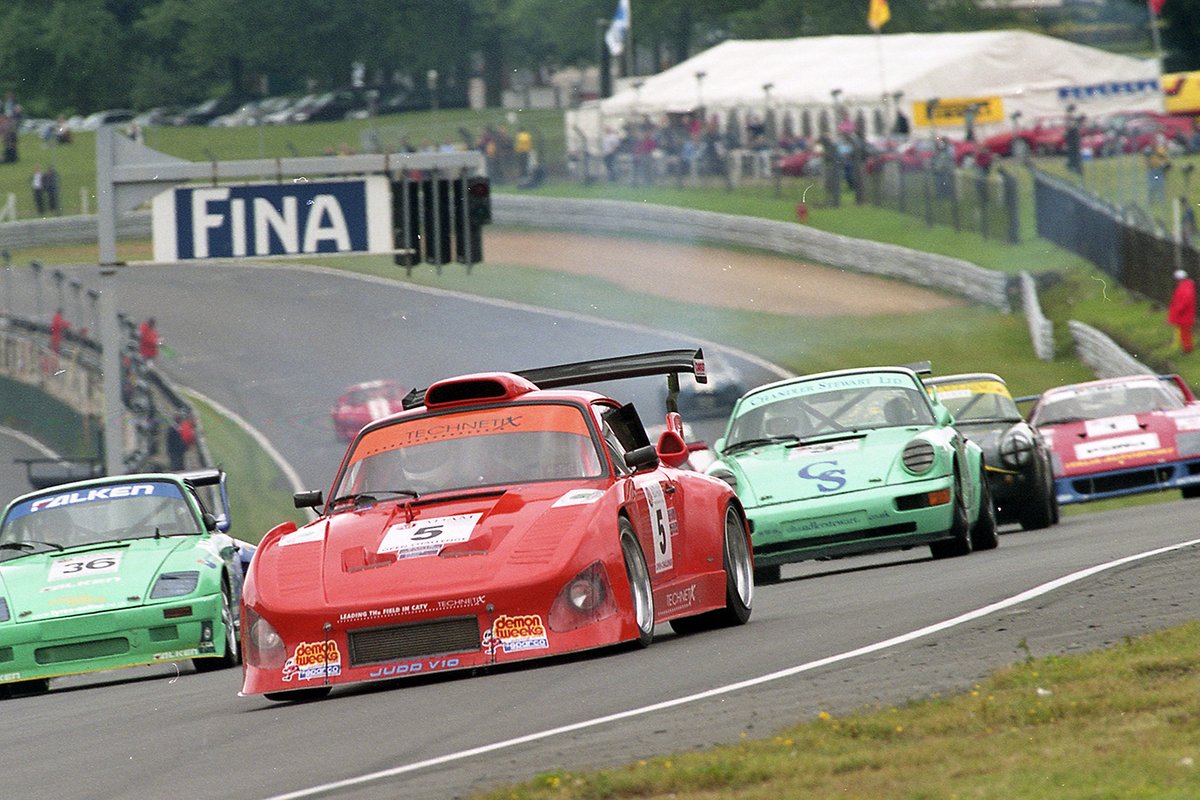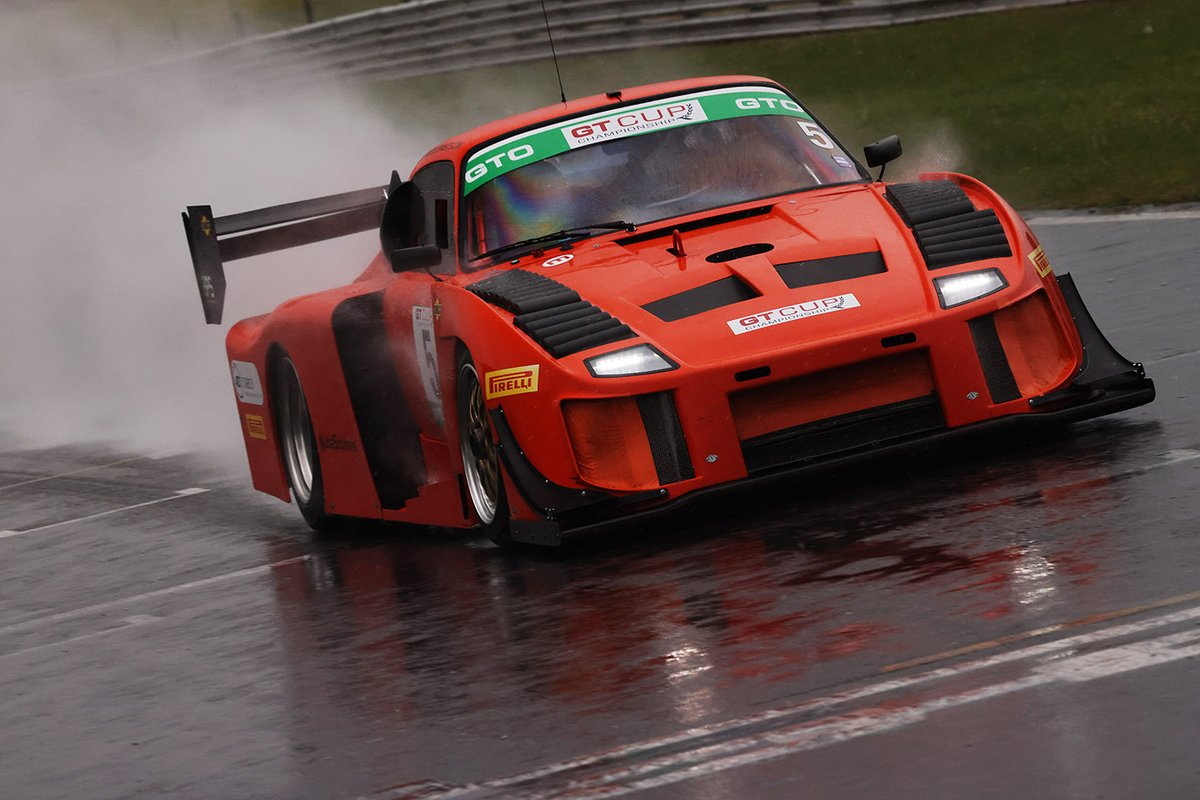
GT racing has boomed in recent years, both internationally and, increasingly so, on the British national racing scene. Its growth has largely been fuelled by the accessibility and competitiveness of the GT3 formula. But a consequence is that low-volume specials that previously populated grids are now few and far between.
Bucking the trend is Huntingdon-based CTR Developments with its self-developed Porsche 935 clone. Richard Chamberlain, his son Matt, and former Empress Race Developments man Tony Frost –recently aided by Peter Weston, previously Dyson Racing’s chief engineer in the American Le Mans Series – run a car capable of giving the GT3s a hard time in the GT Cup.
Never resting on their laurels, it has been a 30-year journey with plenty of setbacks along the way – including a devastating fire in 2017 – while demonstrating what can be done with ingenuity, determination and hard work.
Chamberlain’s passion for motorsport began when, aged 13, he went with a friend to watch karts race at Crystal Palace. Saving up from holiday jobs, the pair bought their own 197 Villiers to share. After some Formula Ford while at university, family life and establishing his successful electronics business then took priority.
Having been caught speeding in his Porsche 911 Carrera road car, Chamberlain realised it wasn’t really suited to everyday driving. So Josh Sadler, of Porsche specialist Autofarm, suggested that Chamberlain went hillclimbing. Plenty of success followed before Sadler encouraged Chamberlain back onto the circuits in the car with which he would become synonymous for the next three decades.

It had been built in the late 1980s from a standard 1972 911E by Mike Youles, with a Bob Watson-supplied engine. With Youles – a future class winner at Le Mans – aboard, it was a prolific winner in modified Porsche and Intermarque races before passing to Chester Wedgwood.
“Like a lamb to the slaughter, I looked at the car he said he was going to sell me, which was the old Mike Youles 3.5-litre RSR,” Chamberlain recalls. “It was a bit rough and ready but it was pretty spectacular. And then they started it up, and it was on open megaphones. Well, I just bought it there and then!”
With the modified Porsche series no longer running, Chamberlain focused on Intermarque through the 1990s, competing against the likes of Gerry Marshall in the Marsh Plant Aston Martin V8, Malcolm Hamilton’s V12-engined Jaguar E-type and Win Percy’s Jaguar XJ220. On occasion, even the Aston Martin Nimrod Group C car would appear, piloted by John Dennehy.
Chamberlain became a regular pacesetter, and was made captain of the Porsche team, but never took the individual crown due to the weighted points structure favouring less modified cars. But a continual arms race required constant development just to stand still compared with the opposition.
The resulting 3.4-litre twin-turbo-powered 935 became so potent that Chamberlain was effectively barred from competing when Intermarque was restructured for 2003
One year, Chamberlain remembers, “We modified it, we lightened it, we got a little bit more horsepower out of the engine and we thought, ‘This is going to be it, we’re just going to whitewash the championship’, but we were wrong. Brian Robinson got his turbocharged 911 going properly, Malcolm had got the V12 going properly, and we were blown into the weeds. I went quicker than the previous year, but it was just hopeless.”
Turbocharging appeared to be an obvious solution but initial attempts proved an expensive dead-end and left Chamberlain sidelined for a season. That disappointment set him on the path to taking on the development himself, rather than employing others’ services.
“I was at my wits’ end,” Chamberlain recalls, “and actually my wife said to me, ‘Look, Richard, I don’t know how much money this has cost, but I do know you’re not enjoying it. Either give up or do it yourself.’”

A trip to Richard Salisbury’s Chatteris-based Empress Race Developments, also in Cambridgeshire, would prove fruitful. Empress had experience of running Judd engines in the Formula 1 Tyrrells of future Minardi owner Paul Stoddart’s European Formula team, which fielded drivers such as Nigel Greensall and F1 technical director Mike Gascoyne in BOSS Formula. Empress recommended Judd for Chamberlain’s engine overhaul.
The resulting 3.4-litre twin-turbo-powered 935 became so potent that Chamberlain was effectively barred from competing when Intermarque was restructured for 2003. Meantime, operating under the Chimp Tune Racing banner – a reference to a schoolboy nickname earned by performing bicycle circus tricks – Chamberlain had employed ex-Empress man Frost. And over the course of a successful multi-year relationship, Judd showed Chamberlain how to tune the engine, allowing him to bring that in-house.
“There are no secrets,” says Chamberlain. “It’s just sound engineering. We do all our engines now but they were the ones that really gave me the confidence to do it.”
CTR Developments – “when we started to get customers, we thought we ought to change it to CTR because that sounds a little bit more professional,” admits Chamberlain – had been a spare-time enterprise until Chamberlain sold his business 20-odd years ago. It continues to operate from the workshop at his house but, with Chamberlain and son Matt both having mechanical engineering degrees, combined with Frost’s motorsport experience, it boasts impressive engineering pedigree as well as design and manufacturing capability.
After a few years dominating the Porsche Open series, Chamberlain switched to the then-new Britcar category, where the main challenge was adapting to longer enduro-style races.
“It was very expensive to do because suddenly you were going from 15-30 minutes races in Intermarque and the Porsche Open to three, four and six-hour races in Britcar,” he says. “So you were gobbling through tyres and fuel and having to rebuild engines every three meetings.”
The next move was to GT Cup, founded by Marc Haynes of the publishing family, where Chamberlain has competed ever since. There, development of the venerable Porsche stepped up another gear. Alongside a Holinger paddleshift gearbox, and further chassis lightening, came the first real foray into aerodynamics beyond the earlier switch to a 935-style front end.

Having had the car 3D-scanned, Chamberlain Jr used computational fluid dynamics to develop new aero surfaces, including a flat floor and longer tail.
“Round somewhere like Donington, on the National circuit, we probably found 2-2.5 seconds a lap, so it was a stunning jump forward,” remembers his father.
But Porsche’s traditional powertrain layout, with the engine hanging out over the rear wheels, was hampering it against more modern machinery. Rotating the engine and gearbox for a better weight distribution would be a massive job. Instead, yet more power was eked out of the air-cooled lump via a flat fan, new cylinder heads and camshafts.
"Every single bit from the B-post back, except the engine and gearbox, we manufactured at home. The car was a lot more stable in the fast corners, it carried more speed to the apex, it would brake more consistently" Richard Chamberlain
Eventually, an incident that could have spelled the end became an opportunity to pursue the mid-engined route. A puncture in qualifying at Silverstone in 2017 caused damage that sprayed oil onto the turbos and the 935 became an inferno.
“It was pretty scary, because the car filled up with horrible acrid smoke instantly, and you just couldn’t breathe,” says Chamberlain. “I got out and watched it burn to the ground. It was destroyed. And once again, I’m really pigheaded so I didn’t give up. So we literally just got a gas axe and cut the back of the car off at the B-pillar.”
A complete redesign rotated the engine, mating it to a Hewland gearbox, and extended the wheelbase by around 300mm. It took more than a year, but everything was done in-house, from CAD design to manufacture using CNC milling machines and lathes. The car made a successful return with three wins from four races first time out at Donington Park in 2019.
“Every single bit from the B-post back, except the engine and gearbox, we manufactured at home,” says Chamberlain. “The car was a lot more stable in the fast corners, it carried more speed to the apex, it would brake more consistently. Very satisfying.”

With the engine now the ‘wrong’ way round, cooling became a problem. So Chamberlain’s next project was to switch to a water-cooled powerplant.
“Anyone with any sense would have bought a 997 turbo engine from a scrapheap and rebuilt it,” he smiles. “But I didn’t do that. I really always wanted to build a 962 engine. The 962C engines had water-cooled cylinders and water-cooled heads. It’s a truly sophisticated, proper race engine. And it’s a very expensive lump and getting the parts is almost impossible.”
Step forward expert Group C engine builder Paul Knapton of Xtec Engineering. After some haggling with 935 engine parts, Knapton built Chamberlain an engine for 2020 – only for COVID-19 to restrict it to a single outing.
“Xtec made a beautiful job of it,” Chamberlain says. “But, interestingly, the engine had considerably less power than the 935 engine, which was a major disappointment to me. And it was a lot heavier as well. So the car put on a fair bit of weight and had lost horsepower, but had gained reliability.”
Development in conjunction with Xtec on ports, valves and camshafts clawed back that power deficit and more. It helped the old warhorse onto the podium at Snetterton last year.
“It was a real mixed bag last year, and I thought the driving standards were appalling,” says Chamberlain. “I actually blew an engine up, which really upset me, because someone hit me in the side of the car and flattened an oil-return pipe. I didn’t know, and 30 seconds later the engine lunched itself. It was disappointing.”
In the continuing quest to keep up with the GT Cup’s GT3s, including British GT outfits on dual programmes, this winter’s development included shedding 30kg via finite element analysis. Having replaced the front suspension’s MacPherson struts with double wishbones last year, the car now has new uprights too.

“We are, I think, almost unique in the pitlane in that we design and build our cars, whereas everyone else goes to the showroom and buys one,” surmises Chamberlain. “We are dinosaurs, let’s be honest. But for us, it’s much more satisfying to make it all at home and compete.”
"A class win is pointless as far as I’m concerned. The only win worth having is a win" Richard Chamberlain
By “compete”, Chamberlain means “win”. His Porsche 935 might fall into GT Cup’s Open class, away from the GT3-spec cars, but Chamberlain isn’t interested in class honours.
“A class win is pointless as far as I’m concerned,” he says. “The only win worth having is a win. I’m very keen to be able to beat them. We haven’t given up!”








